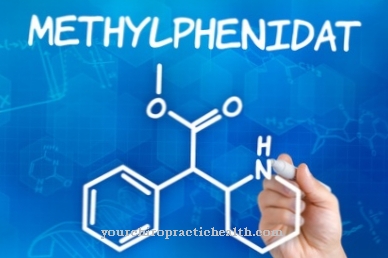Cephalosporins represent a group of antibiotics derived from Cephalosporin-C. Like penicillins, they contain a beta-lactam ring, which is responsible for the effectiveness of these medicines against bacteria. Cephalosporins are generally well tolerated and have fewer side effects than other antibiotics.
What are cephalosporins?

Cephalosporins are antibiotics that work through the beta-lactam ring. There are a variety of cephalosporins. However, their basic structure is the same. They contain a beta-lactam ring as the most important structural element. Only the groups of atoms on opposite ends of the molecule vary. There are many combinations that also form the basis for a number of different antibiotic drugs.
Cephalosporins can be divided into six different groups based on their spectrum of activity. All active ingredients have in common that they disrupt the structure of the cell wall of bacteria. The effectiveness of the individual cephalosporins varies and is only influenced by the different atom groups that are bound to the chemical framework of the molecule.
The group 1 cephalosporins are poorly effective. The only representative of this group is still cefazolin today. In addition, a second group of active ingredients includes the so-called transitional cephalosporins, which are mainly used to combat the Haemophilus influenzae germ. The third group includes antibiotics, which are particularly effective against anaerobic bacteria.
Another group contains broad-spectrum cephalosporins. They work against both gram-positive and gram-negative bacteria. Narrow-spectrum cephalosporins are only effective against Pseudomonas aeruginosa. All five groups mentioned can only be administered by infusion, as they would be destroyed if ingested orally. However, there are also persistent cephalosporins that can be ingested orally and thus are grouped into a sixth group.
Pharmacological effect
The pharmacological effect of the cephalosporins results from the blockage of the bacterial enzyme transpeptidase by the beta-lactam ring in the molecule. The transpeptidase is responsible for building up the murein layer of the bacterial cell wall. It catalyzes the connection of N-acetylglucosamine with N-acetylmuramic acid, which forms the basis for the murein layer.
When cephalosporins act on the transpeptidase, the beta-lactam ring opens, creating a bond with the active centers of the enzyme. The enzyme is inactivated and the bacterial cell wall does not build up. However, existing cell walls are not attacked. Only the structure of the murein layer when the bacteria multiply is disturbed. This inhibits bacterial growth.
The structure of the cell walls of gram-positive and gram-negative bacteria is different. Although all bacteria form murein layers in the cell wall, this layer is thinner in gram-negative bacteria. Some bacteria also produce the enzyme beta-lactamase, which destroys the beta-lactam ring in antibiotics. The individual cephalosporins develop different efficacies. If, for example, the side atom groups can shield the beta-lactam ring well against beta-lactamase, the corresponding cephalosporin is also able to fight bacteria on which other antibiotics have already lost their effectiveness.
Medical application & use
As an active ingredient class, the cephalosporins have a broad spectrum of activity. Not all antibiotics in this group of substances work against all bacteria, but different cephalosporins can fight different germs. Therefore, these active ingredients are widely used in bacterial infectious diseases.
To use it, however, it is important to know which bacteria are present. The broad-spectrum cephalosporins ceftazidime, ceftriaxone, cefotaxime or cefodizime, among others, act against several bacterial strains. Cefsulodin is, in turn, a narrow-spectrum cephalosporin, which is only effective against Pseudomonas aeruginosa. The transitional cephalosporins cefuroxime, cefotiam or cefamandol are used in infection with Haemophilus influenzae.
All of the cephalosporins mentioned can only be injected, as they would be inactivated if absorbed via the digestive tract. The active ingredients cefizim, cefalexin or cefaclor can be taken orally.
The most important areas of application for cephalosporins include respiratory infections, tonsillitis, otitis media, urinary tract infections and skin infections. These active ingredients are also frequently used for Lyme disease and meningitis. However, all known cephalosporins are ineffective against enterococci, because they have primary resistance to this class of active substances.
Risks & side effects
In general, cephalosporins are well tolerated. In contrast to other antibiotics, side effects are rare. Furthermore, this class of active ingredients can also be used without hesitation in pregnant women and children.
Nevertheless, the cephalosporins are not entirely free from side effects. About ten percent of patients treated with cephalosporins complain of symptoms. The most common complaints include digestive problems such as diarrhea, nausea and vomiting. However, these gastrointestinal complaints are much more common when other antibiotics are used.
A pseudomembranous colitis was also observed in individual cases. It has not yet been investigated whether this problem also occurs with other antibiotics. About one percent of patients have skin problems with rashes and itching. Neurological complaints such as headaches and haematological changes are even rarer.
Allergic reactions are also very rare with cephalosporins. These only occur in people who are also allergic to penicillin. Cross-allergies between cephalosporins and penicillin are found in two to ten percent of patients. Cephalosporins should not be used in patients who have had anaphylactic shock on penicillin.
Orally ingested cephalosporins may reduce the effectiveness of live vaccines and contraceptives.



























